Selecting objects to display¶
So far we have a flow that lets you take photo and then display all of the detected objects in it.
In this part of the workshop we're going to change the flow to let the user select which object to highlight in the displayed image.
Before we do that, we need to rearrange the nodes to make some space for what we'll be adding in this section.
Here is what we have so far:
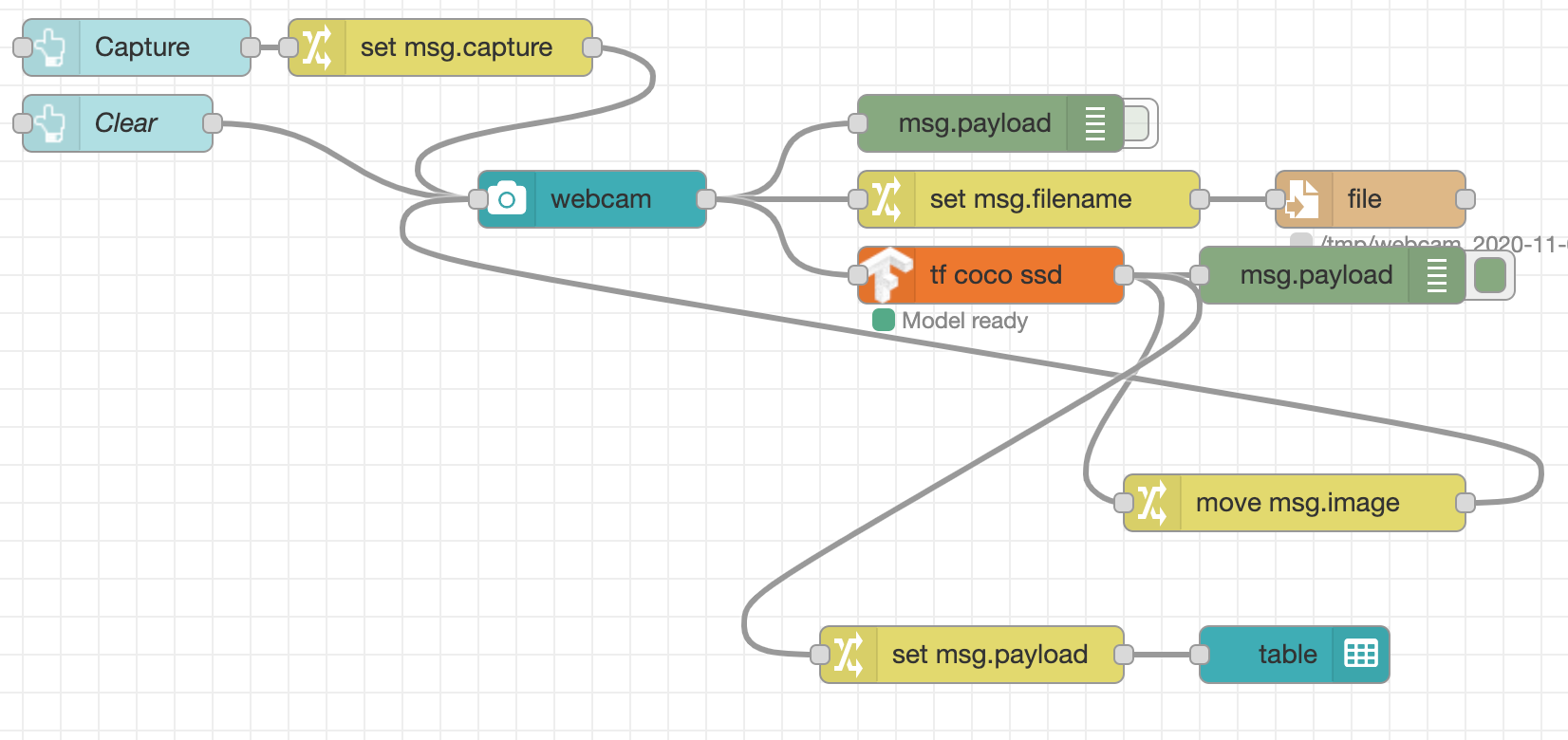
With a bit of moving around we can get to the following:
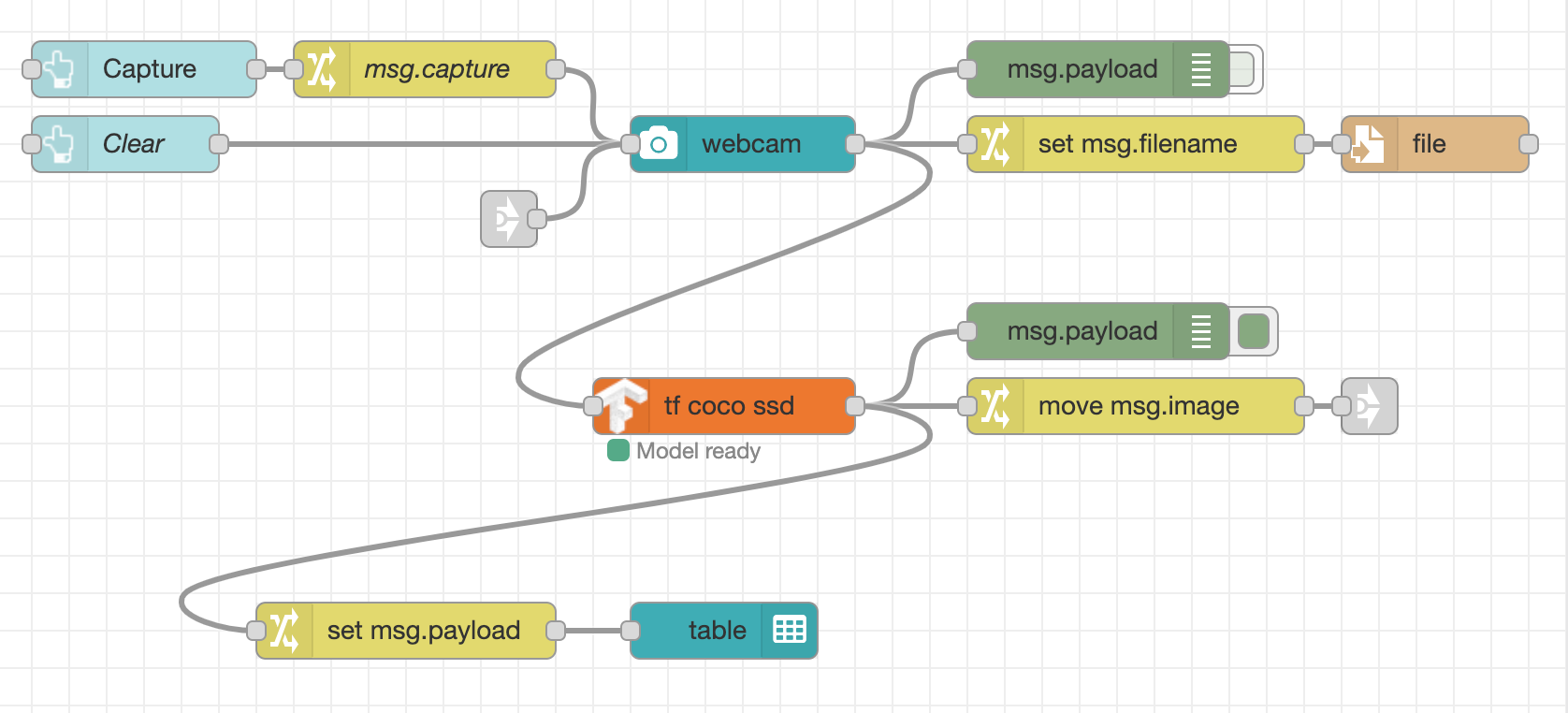
The main addition is the pair of Link nodes - a Link In node wired to the input of
the webcam node, and a Link Out node wired to the output of the move msg.image
Change node. Link nodes allow you to create virtual wires that only get shown
when you select a link node at either end. This can help reduce some of the
visual complexity of a flow.
Wiring Link nodes
You can wire Link nodes together in two ways. One way is to double click on a Link node to open its edit dialog. Then select which nodes it should be connected to from the list shown. The nodes are listed by their name or id. It is always worth naming your link nodes to help you identify them in the list. This method can be used to join link nodes that are on different tabs in the editor.
The other way of connecting a pair of link nodes is to first select a node to reveal its 'virual port' and then drag a wire from that port to another link node just as you would wire regular nodes.
Making the table selectable¶
We need a way for the user to select the object to display and then regenerate the annotated image with just the selected object.
The ui_table we added in the last step can be used to select the object.
-
Edit the table node and enable the 'Send data on click' option.
The table node should now have an output port.
-
Add a Debug node and wire it to the table node output.
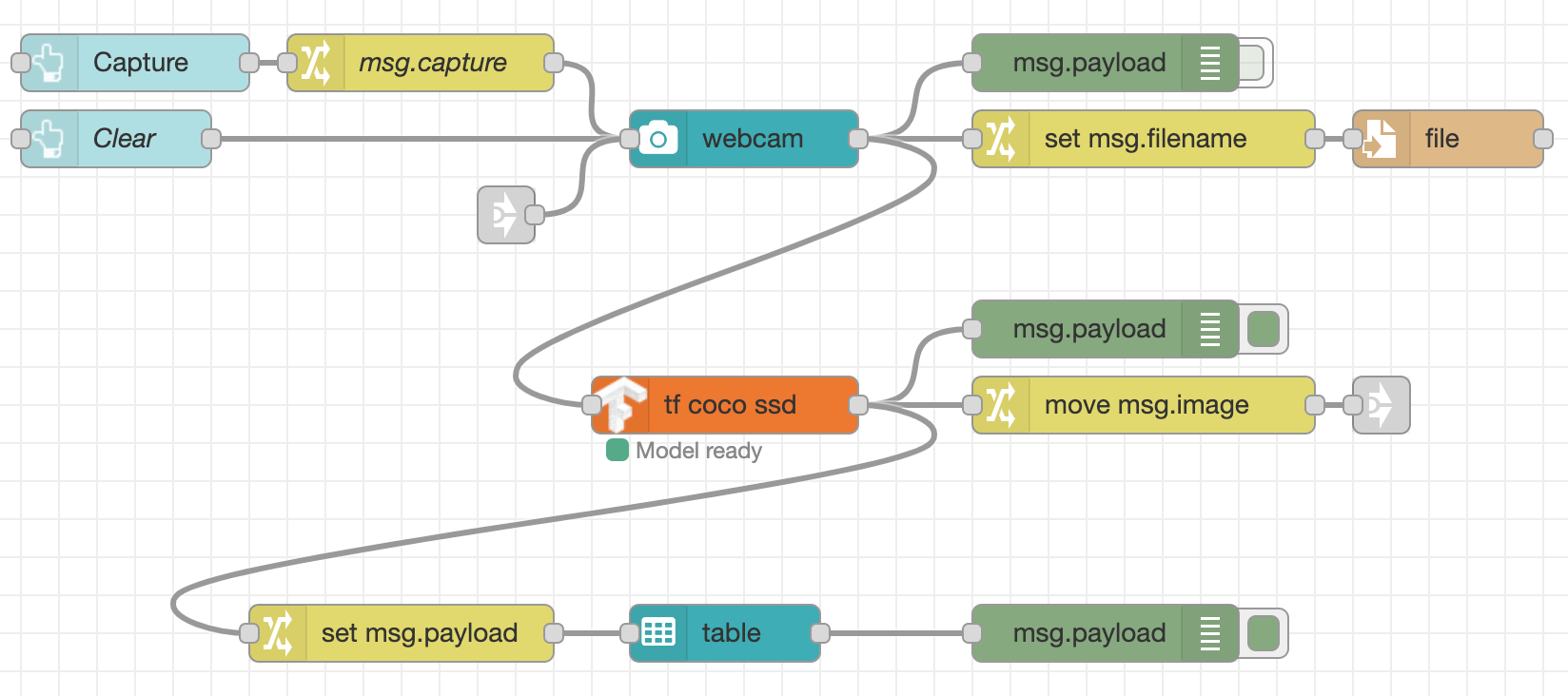
Now when you select an object in the dashboard table you will see a message arrive in the Debug sidebar with the object's information. It will look something like:
{
"class": "person",
"score": 64.49049711227417,
"bbox": [
5.880241394042969,
49.79872226715088,
517.5165557861328,
429.3963575363159
],
"id": 0
}
Annotating the image¶
The TensorFlow node we are using generates the image with all detected objects annotated. It doesn't provide a way to retrospectively generate the image with only a particular object highlighted.
To do that we can use another module: node-red-node-annotate-image.
This module can be installed from the Manage Palette option in the editor, or by
running the following command in ~/.node-red:
npm install node-red-node-annotate-image
Once installed, you will find a node called annotate-image in the Utility category
of the palette.
- Add a new
annotate-imagenode into your workspace. - If you've added the Link nodes like we did at the start of this section:
- Wire the output of the
annotate-imagenode to the add a new Link Out node - Link the new Link Out node to the Link In node connected to the webcam node.
- Wire the output of the
- If you haven't added the Link nodes, wire the output of the
annotate-imagenode directly to the input of theui_webcamnode.
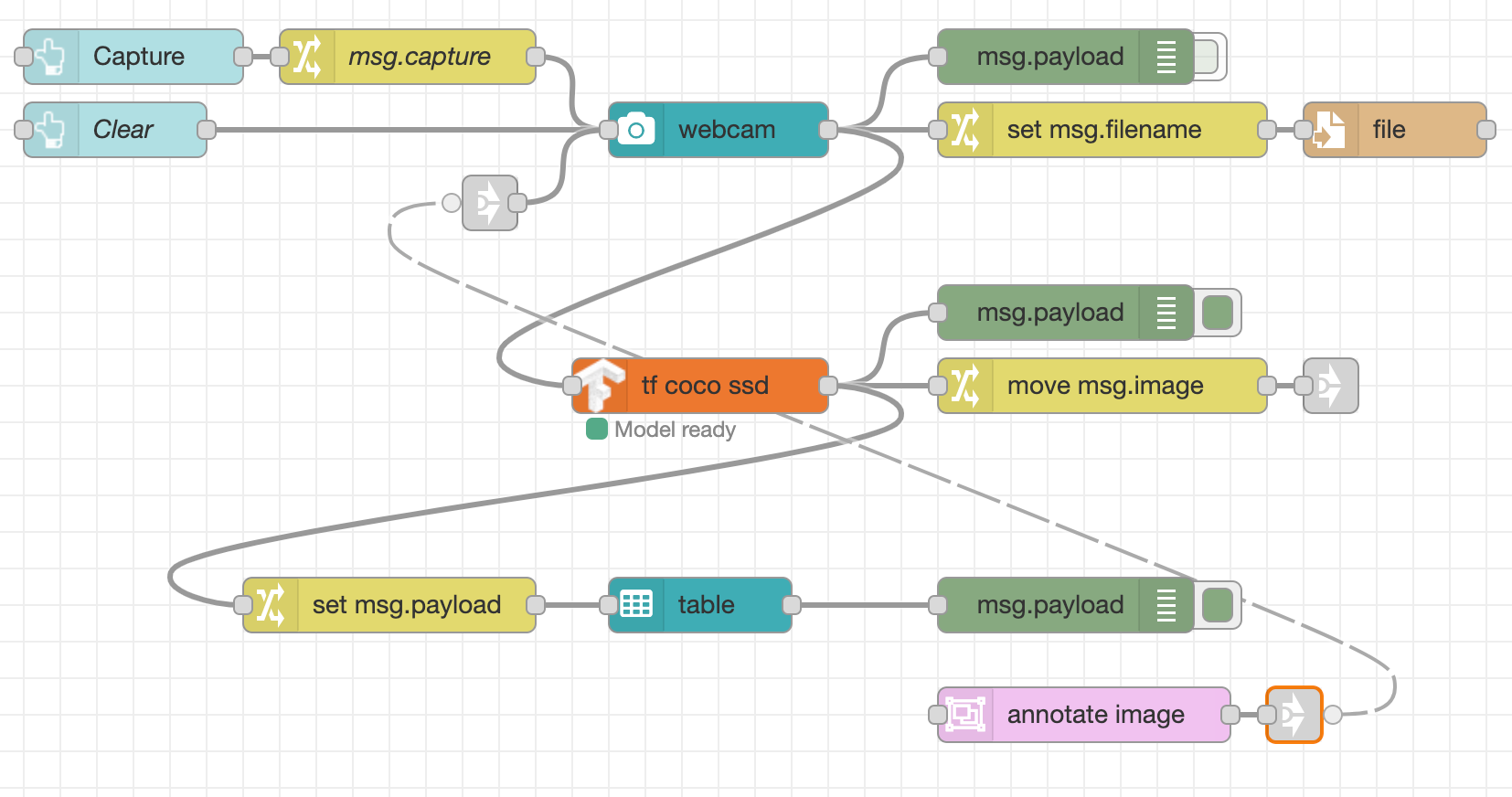
Note
In this screenshot, the virtual wire is show because the Link Out node is selected.
The next task is to take the output of the ui_table node when an object is clicked
and get it into the right format required by the annotate-image node.
The annotate node expects two properties to be set on the message it is sent:
- msg.payload should be a Buffer containing the image in JPEG format
- msg.annotations should be an array of the annotations it should apply to the image.
Storing the image¶
In order to annotate the image, we need a copy of the image to work on. The flow
we're working on is triggered when the user clicks on a row in the ui_table. This
happens as a new event - it isn't tied to original event that captured the image.
This means we need some way to get ahold of the original image in this new flow. We can use Context to do that.
Introducing "Context"
"Context" is a way to store information in Node-RED that is not tied to individual messages passing through the flow. For example, it can be used to store global state that needs to be shared amongst flows.
For more information about context, read the documentation.
The first task is to store the image in context whenever a photo is taken.
- Add a Change node in between the
ui_webcamandtf coco ssdnodes. - Configure the node to set
flow.imageto the value ofmsg.payload.
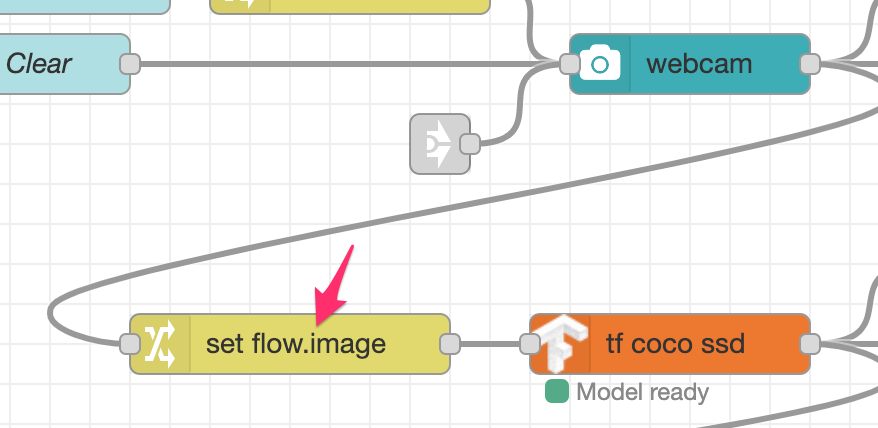
The next task is to retrieve that image and add it to the messages coming from
the ui_table node.
- Add a Change node and wire in between the output of the
ui_tablenode and theannotate-imagenode. - Configure the node to set
msg.payloadto the value offlow.image- this is essentially the reverse of the operation done in the previous task.

Creating the annotations¶
As shown earlier, the payload coming from the ui_table node looks like this:
{
"class": "person",
"score": 64.49049711227417,
"bbox": [
5.880241394042969,
49.79872226715088,
517.5165557861328,
429.3963575363159
],
"id": 0
}
In order draw that as an annotation on the image, the annotation node expects
msg.annotations to be a array containing an object like this:
[
{
"label": "person",
"bbox": [
5.880241394042969,
49.79872226715088,
517.5165557861328,
429.3963575363159
]
}
]
You can see they are very similar, but some work is needed to map between them.
- Edit the Change node added in the previous step (between the
ui_tableandannotate-imagenodes) - Add a new rule, and then drag it to the top of the list of rules. This is
important because the new rule will use the information in
msg.payloadso needs to be applied before the rule that overwritesmsg.payloadwith the image data. - Configure the new rule to set
msg.annotationsto the expression type and set the expression to:$append([],payload.{"label": class, "bbox": bbox})This will create an array of annotations with just the
labelandbboxproperties set from the original object.
Testing JSONata Expressions
Node-RED provides an editor for JSONata expressions with the ability to test the expression whilst working on it.
-
Click on the expand button next to the Expression:

-
This opens the JSONata editor. You can edit the expression in the top pane. In the lower pane is a Function Reference and a Test tab. Click on the Test tab. This shows an example message on the left and the result of the expression on the right.
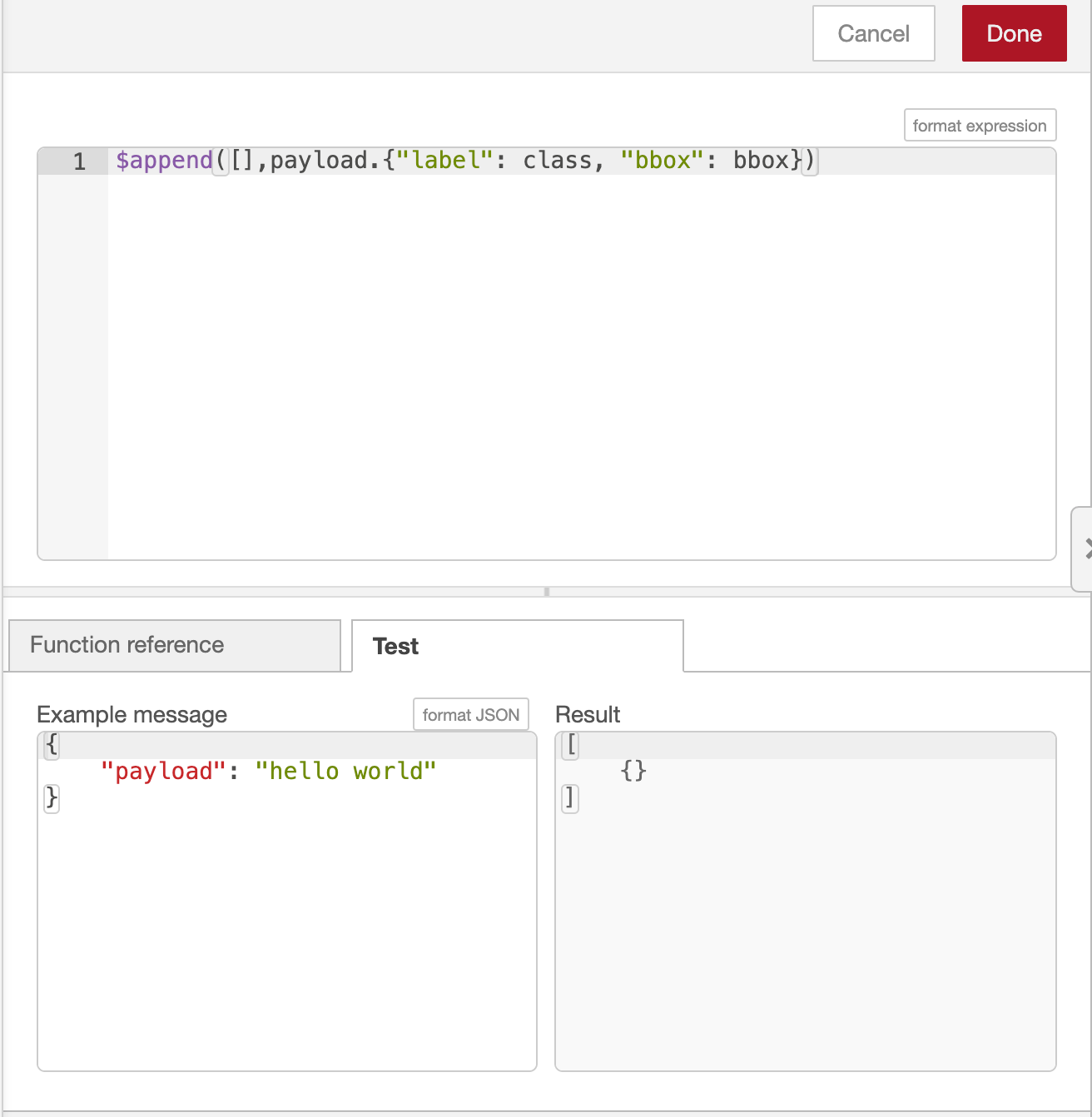
-
Copy the example output of the annotate node from above and replace the
"hello world"example payload. You should see the result update with shown here.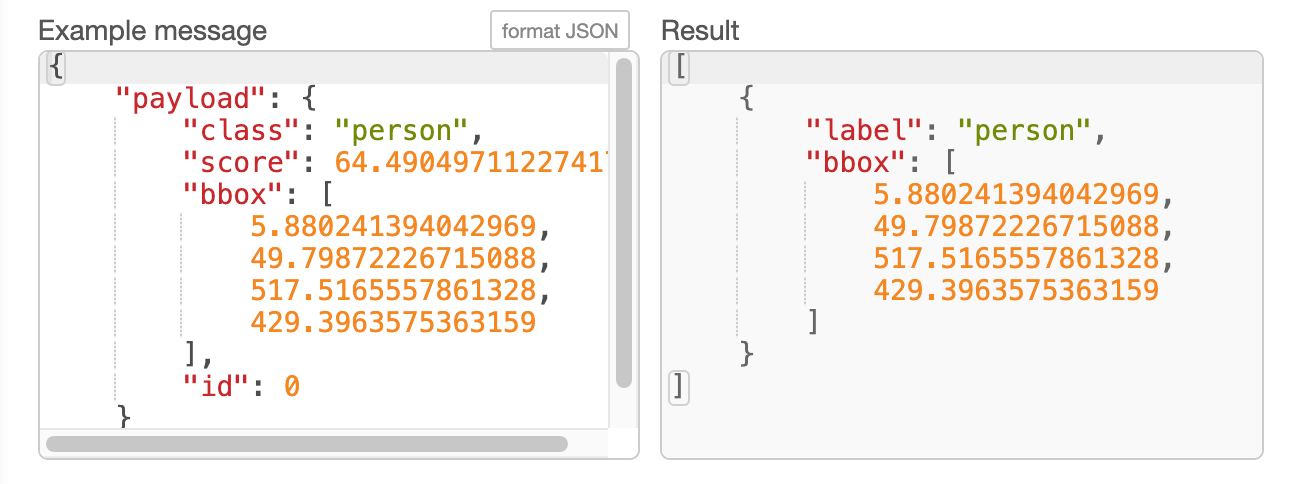
You should now have a flow that starts with the ui_table node, passes through
a Change node to format the message, then to an annotate image node and finally
to the ui_webcam node, possibly via a Link node.
Before deploying these changes there are couple more changes to the flow needed.
We aren't going to use the image produced by the tf coco ssd node anymore.
- Delete the
move msg.imageChange node that is connected to the output of thetf coco ssdnode. If you added the Link Out node, delete that as well. - Edit the
tf coco ssdnode to set the Passthru option tonothing - Click the Deploy button to save your changes.
Now when you capture an image on the webcam, you'll see the captured image on the dashboard without any annotations. The table below the image will list the detected objects. Clicking on an object will update the image to highlight the selected image.
This is what the final flow should look like:

Next Steps¶
With the application complete, the next task is to wrap it in a container.